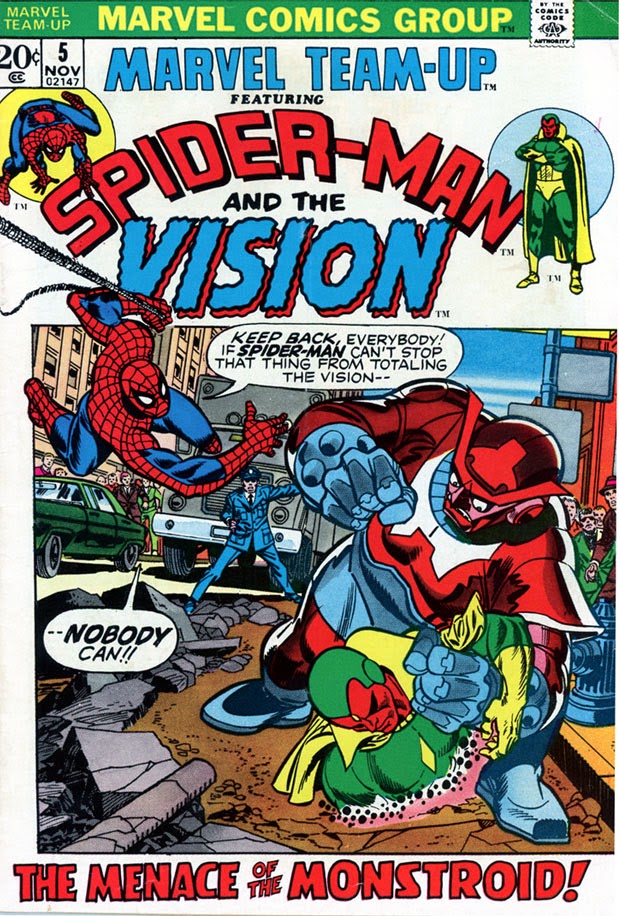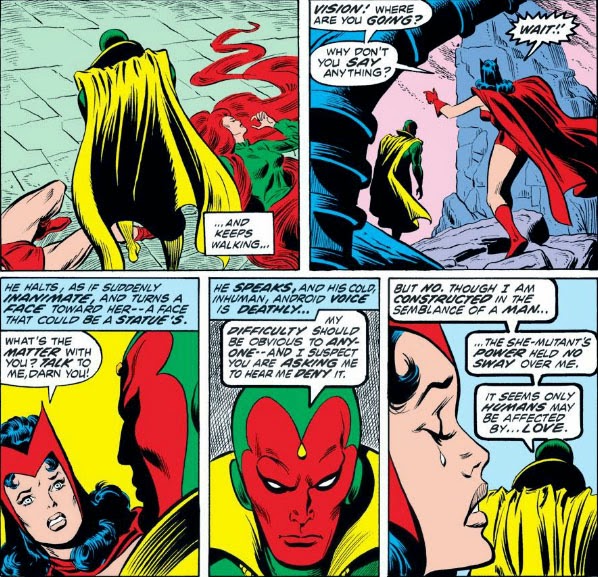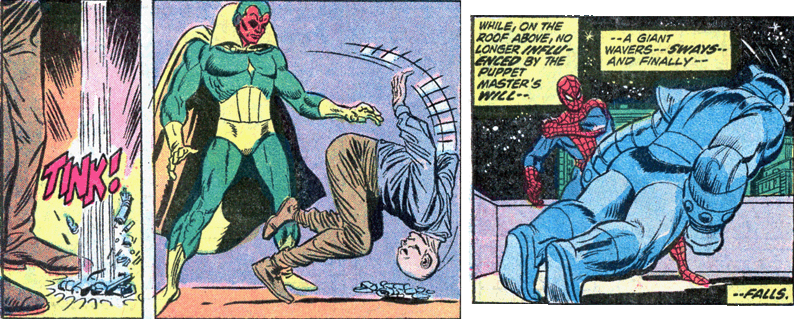Back when Marvel Team-Up was just beginning to catch on, some readers were wondering if this concept was realistic, comic book or not. As one letter-writer put it, "Spider-Man doesn't belong as part of a duo, trio, or quartet. He is a loner by nature, an outcast." And that was a fair point in those days. An attempt to join the Fantastic Four didn't work out (for reasons having to do with finances as well as Spidey's questionable standing with the law), nor did the Avengers have any better luck. Also, despite the mag's title, "Marvel Team-Up" shaped up to be a comic headlined by Spider-Man--and in the process of Spider-Man teaming up with another hero to tackle a foe, there would be no room left for the other elements present in Amazing Spider-Man that made both Spider-Man and Peter Parker stand out among the crowd, at least beyond casual references and cameo appearances.
Yet still the title caught on, and it's difficult to argue with success. And if you were to read Team-Up #5, you might come out of it thinking that this concept wasn't so unworkable after all. There would still be a long grace period involved where Spider-Man is meeting his team-up partner(s) for the first time, before the mag reached the point where it became "Spidey's Super-Friends" and took his camaraderie with other heroes for granted; even so, the ease at which Spider-Man and his partner du jour become team players (presumably to accommodate the limited number of pages available for the story) at times makes you want to pull out an issue of Amazing Spider-Man immediately afterward and read a story that doesn't have Spidey billed with a "guest-star."
The flip side of Marvel Team-Up is that, regardless of the conflicting feelings it gave you of seeing Spider-Man team up with someone on a regular basis, its cover marquee was always eye-catching and couldn't help but pique your curiosity. I think this issue is the first I recall of the Vision's name being part of a masthead, as well as having his name distinguished with a title style. There was also the fact that, unlike the Human Torch and the X-Men, who appeared in the prior four issues, the Vision was a character whom Spider-Man had never met before, which would give this story a little extra development to feature. And since this is the Vision, writer Gerry Conway and artist Gil Kane begin this story by making his first impression with Spider-Man a memorable one:
It's unfortunate that the Vision will spend much of this story debilitated--because even though his condition will connect with other parts of the story, the Vision is prevented from bringing his unique style and approach to dealing with the problem at hand, either separately or in tandem with Spider-Man. It's something of a "non"-team-up you'll see here, as it's Spider-Man who will really battle in earnest in this issue, while the Vision... well...
Yet this first meeting between the two is still interesting reading, as Spider-Man helps to diagnose the Vision's unexplained epileptic seizures and the two trace the problem to its source. Spidey of course asks the question of the day: Why isn't the Vision seeking help from the Avengers? The Vision won't go into it with Spider-Man--but he's out on his own this night because he's upset from an earlier incident involving a recent battle, where a foe's mesmerizing power held all the male Avengers in sway. All except one:
But while Spidey works out a plan to help the Vision, let's turn to this story's villain--the Puppet Master, who investigates a space ship that's crashed close to his beachfront house (as opposed to you or I, who could live 457,910 lifetimes without seeing a space ship crash outside our home), and discovers a new weapon with which to take vengeance on the Fantastic Four:
It looks like the field test for Ballox--er, the Monstroid is a complete success. I wouldn't have expected even a doll created by the Puppet Master to work on a robotic construct and override its own programming--but obviously those poor policemen would beg to differ with me.
As the Puppet Master heads for the Baxter Building, Spidey and the Vision are heading to check out the Vision's condition:
The Vision is then stopped short by another seizure--just as another seizure of sorts is taking place on the roof of the Baxter Building, where the Puppet Master and the Monstroid are insisting on seizing the premises:
Reed obviously doesn't plan for every contingency--in this case, a foe that destroys his rooftop weapon and then conveniently gains access through the roof port it rose out of. The Puppet Master also catches a break in the fact that, as is the case in most team-up stories that involve the resources of characters not on the marquee, no one is home.
But the Baxter Building is about to receive more unexpected visitors, as the Vision and Spidey close in on the apparent source of the Vision's problem:
The Puppet Master sics the Monstroid on the two on arrival, with the Vision going down first--not from the Monstroid's attack, but literally down into the structure due to another seizure that renders him helpless. And it falls to Spider-Man to take on this powerful alien robot:
With the Vision out of the picture, Kane and Conway give Spider-Man a fight sequence that reads as if we'd picked up a copy of Spidey's regular title, one so entertaining to read that we barely miss the Vision's absence from it, if at all. Will he eventually take a hand in this fight? Perhaps, though not in facing the Monstroid:
I wouldn't call this "far, far more," as Conway puts it, since seeing the Vision doubled over in a seizure is something that so far has been pretty routine, whatever its connection to the Monstroid. And it's the Monstroid who's providing more excitement at the moment:
With that last strike, you may think that this battle is winding down, at least topside. But below, confronting the Vision, the Puppet Master shows he has a few foot moves of his own:
Yes, I can tell what you're probably thinking. The Puppet Master may be aggressive when he's holding a doll and directing another's attack, but he's certainly no Batroc. And as the Vision recovers, the Monstroid may be turning the tables on his agile foe:
Finally, though, it's the Vision who gets through to the Puppet Master and ends this fight. And when the Vision "gets through" to you, he gets through:
It doesn't add up that the Monstroid would collapse with the shattering of the Puppet Master's doll, since that usually only means the Puppet Master's control over his pawn is gone. Regardless, with the Vision's brief linkage to the Monstroid's "memories," he's able now to fill in Spider-Man on not only the reason behind his seizures, but also the robot's origins:
If the story's ending panels seem awkward to you, that usually seems to be the case when the time comes to part the teamed heroes and send them on their separate ways with barely a wave and a backward glance. With all that's happened since they met, it shouldn't really be nagging at Spider-Man as to why the Vision was walking around by himself; and if what happened with the Avengers is indeed a private matter to the Vision, why nevertheless assure Spider-Man that he'll disclose those details at a later time? Perhaps the effort is being made by Conway et al. to avoid story endings in this title appearing similar to each other with a "thanks/shake hands/see you later/mutual praise/gotta be somewhere" approach to the parting. That doesn't mean you can't be creative with such an ending--for instance, how cool would it have been to see the Vision reach out to shake hands, only to sucker Spidey with one that's intangible?
 | Marvel Team-Up #5 Script: Gerry Conway Pencils: Gil Kane Inks: Mike Esposito Letterer: John Costanza |



























5 comments:
The fun of Marvel Team-Up (and Two-In-One) was seeing who Spidey (and the Thing) would team up with each time. No more no less than that.
I loved Marvel Team-Up. I know this isn't a popular opinion, but part of the reason is that we get to enjoy the wonderful Spider-Man character without all of the bad luck, angst, and drama that accompanies ASM. I always felt they laid the "Peter Parker has bad luck" routine on way too thick in his regular mag. Besides, two superheroes is almost always better than one!
The Vision was always one of my favorite characters, so this is one I'd have picked up if I had actually seen it on the newsstand.
Colin and dbutler, you bottom-line MTU reasonably well. It was fun browsing the racks and discovering who the new guest-star was with Spidey--a bad choice or a good one, you were always intrigued. And true, there wasn't really room in the story for Peter Parker's usual baggage. To tell you the truth, though, I missed J. Jonah Jameson, who could have still supplemented Spidey's appearance nicely even if he'd just had three or four panels of exposure.
I picked this one up VF+ last year.., wasn't toooo crazy about the Kane art at times but nevertheless, was great to see Spidey/Vish together in the early Bronze timeframe.
Kudos to Conway for striving for cross-issue continuity.., adding to the Vish's mysteriousness, beyond just the simple team-up tale here.
I agree about the strong continuity here, david_b. I had noticed that too.
Post a Comment